The Treatment of Anorexia Nervosa in Adolescents: Parental Viewpoint
VerifiedAdded on 2021/02/20
|56
|20000
|108
Report
AI Summary
This report presents a metasynthesis of qualitative studies focusing on parental perspectives regarding the treatment of Anorexia Nervosa (AN) in adolescents. It explores the burden of AN, including its classification, epidemiology, and co-morbidity, and highlights the significant role parents play in their child's recovery. The report delves into the methodology used, including literature searches, the rationale for metasynthesis, and the study design, search strategy, and selection criteria, along with the assessment of article quality and thematic analysis. The findings, derived from analyzing multiple articles, cover various themes, such as the causes, symptoms, and prevalence of AN, the significance of treatment, diagnosis and impact on families, and the effectiveness of family-based therapy (FBT), including the challenges and limitations. The discussion section synthesizes these findings to provide insights into optimal treatment outcomes from a parental viewpoint, aiming to improve care for young people with AN. The report also provides an overview of the diagnostic criteria for AN, epidemiological data, and the importance of early intervention. The study underscores the value of qualitative research in understanding complex issues within the treatment of AN and its impact on families.
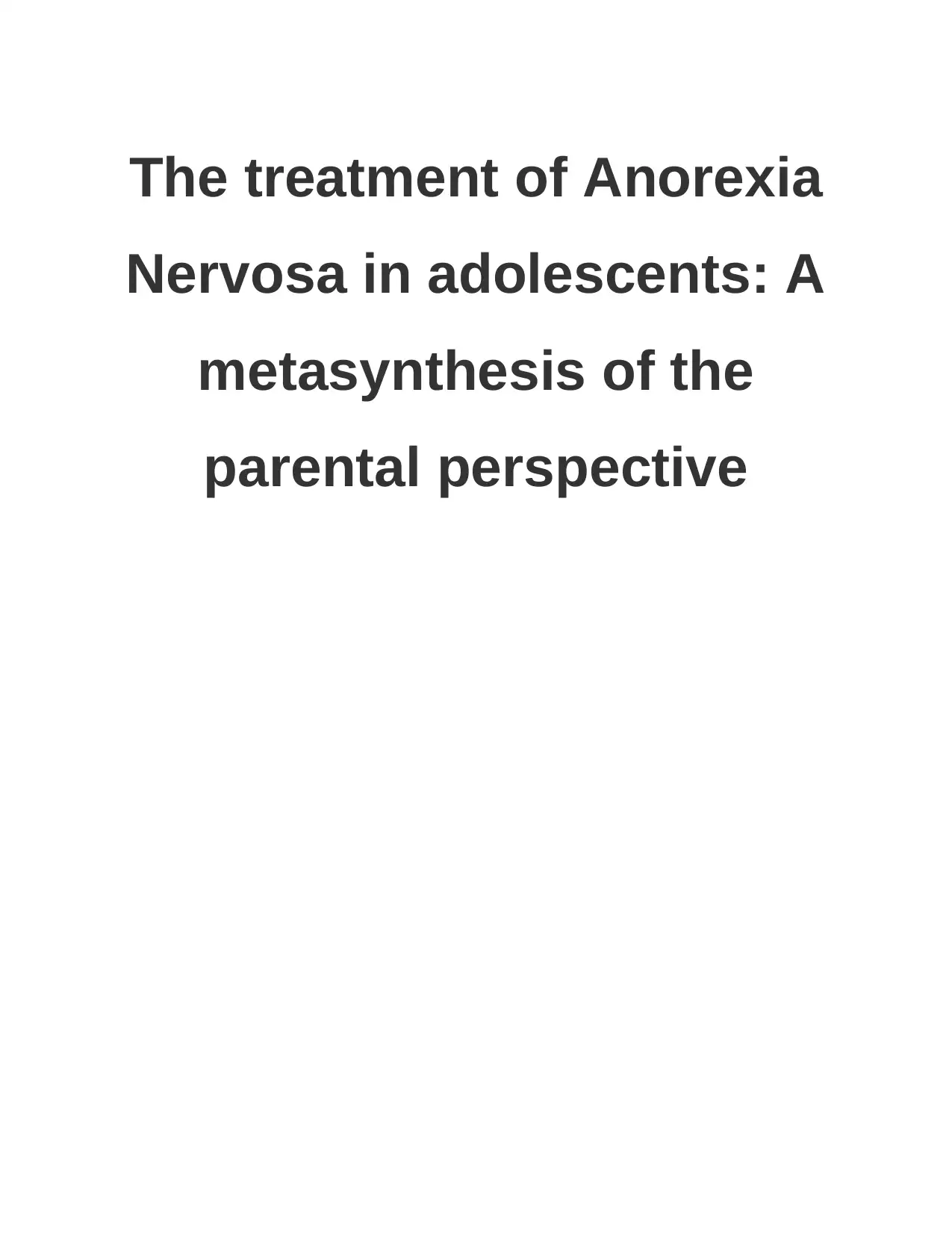
The treatment of Anorexia
Nervosa in adolescents: A
metasynthesis of the
parental perspective
Nervosa in adolescents: A
metasynthesis of the
parental perspective
Paraphrase This Document
Need a fresh take? Get an instant paraphrase of this document with our AI Paraphraser
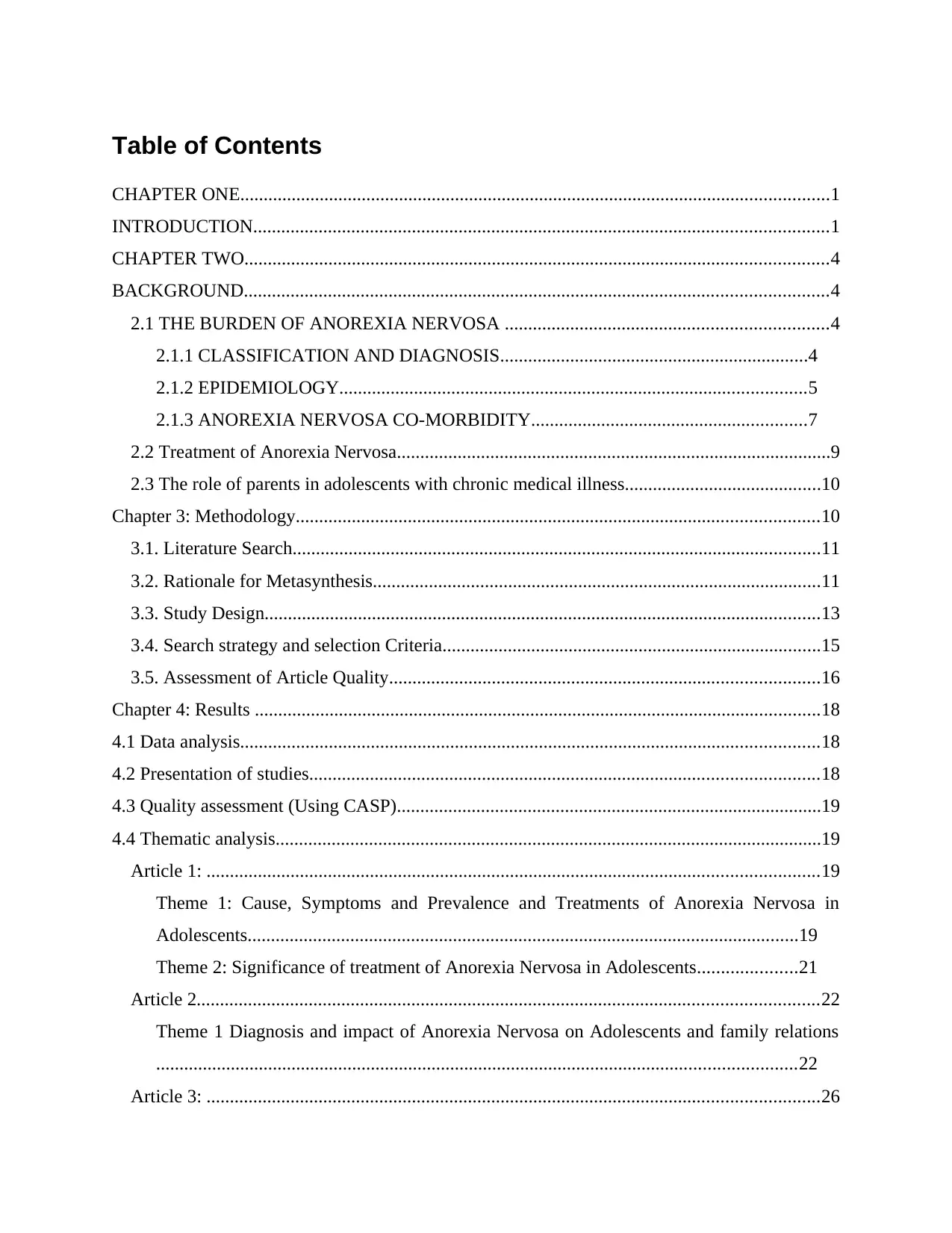
Table of Contents
CHAPTER ONE..............................................................................................................................1
INTRODUCTION...........................................................................................................................1
CHAPTER TWO.............................................................................................................................4
BACKGROUND.............................................................................................................................4
2.1 THE BURDEN OF ANOREXIA NERVOSA .....................................................................4
2.1.1 CLASSIFICATION AND DIAGNOSIS..................................................................4
2.1.2 EPIDEMIOLOGY....................................................................................................5
2.1.3 ANOREXIA NERVOSA CO-MORBIDITY...........................................................7
2.2 Treatment of Anorexia Nervosa.............................................................................................9
2.3 The role of parents in adolescents with chronic medical illness..........................................10
Chapter 3: Methodology................................................................................................................10
3.1. Literature Search.................................................................................................................11
3.2. Rationale for Metasynthesis................................................................................................11
3.3. Study Design.......................................................................................................................13
3.4. Search strategy and selection Criteria.................................................................................15
3.5. Assessment of Article Quality............................................................................................16
Chapter 4: Results .........................................................................................................................18
4.1 Data analysis............................................................................................................................18
4.2 Presentation of studies.............................................................................................................18
4.3 Quality assessment (Using CASP)...........................................................................................19
4.4 Thematic analysis.....................................................................................................................19
Article 1: ...................................................................................................................................19
Theme 1: Cause, Symptoms and Prevalence and Treatments of Anorexia Nervosa in
Adolescents......................................................................................................................19
Theme 2: Significance of treatment of Anorexia Nervosa in Adolescents.....................21
Article 2.....................................................................................................................................22
Theme 1 Diagnosis and impact of Anorexia Nervosa on Adolescents and family relations
.........................................................................................................................................22
Article 3: ...................................................................................................................................26
CHAPTER ONE..............................................................................................................................1
INTRODUCTION...........................................................................................................................1
CHAPTER TWO.............................................................................................................................4
BACKGROUND.............................................................................................................................4
2.1 THE BURDEN OF ANOREXIA NERVOSA .....................................................................4
2.1.1 CLASSIFICATION AND DIAGNOSIS..................................................................4
2.1.2 EPIDEMIOLOGY....................................................................................................5
2.1.3 ANOREXIA NERVOSA CO-MORBIDITY...........................................................7
2.2 Treatment of Anorexia Nervosa.............................................................................................9
2.3 The role of parents in adolescents with chronic medical illness..........................................10
Chapter 3: Methodology................................................................................................................10
3.1. Literature Search.................................................................................................................11
3.2. Rationale for Metasynthesis................................................................................................11
3.3. Study Design.......................................................................................................................13
3.4. Search strategy and selection Criteria.................................................................................15
3.5. Assessment of Article Quality............................................................................................16
Chapter 4: Results .........................................................................................................................18
4.1 Data analysis............................................................................................................................18
4.2 Presentation of studies.............................................................................................................18
4.3 Quality assessment (Using CASP)...........................................................................................19
4.4 Thematic analysis.....................................................................................................................19
Article 1: ...................................................................................................................................19
Theme 1: Cause, Symptoms and Prevalence and Treatments of Anorexia Nervosa in
Adolescents......................................................................................................................19
Theme 2: Significance of treatment of Anorexia Nervosa in Adolescents.....................21
Article 2.....................................................................................................................................22
Theme 1 Diagnosis and impact of Anorexia Nervosa on Adolescents and family relations
.........................................................................................................................................22
Article 3: ...................................................................................................................................26
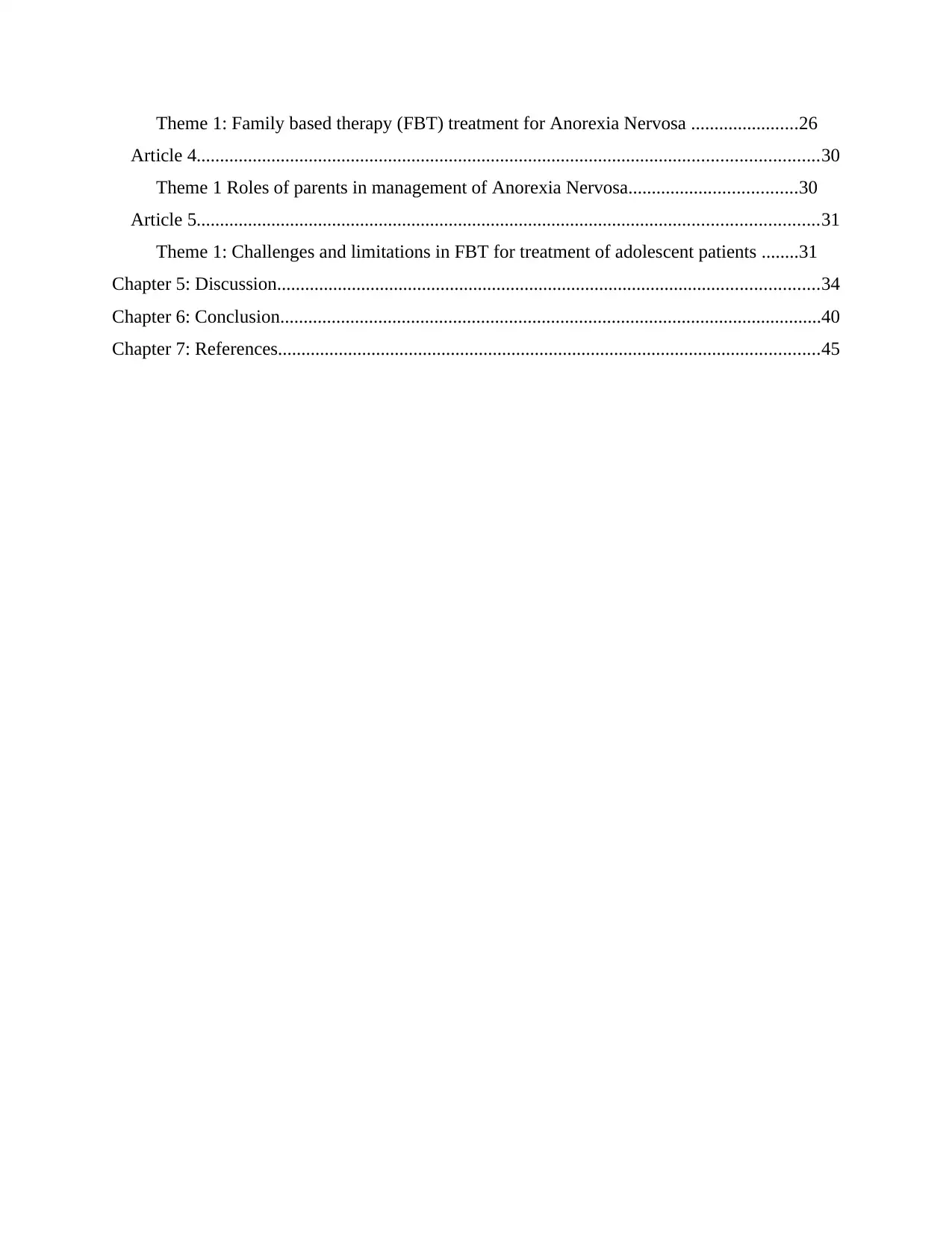
Theme 1: Family based therapy (FBT) treatment for Anorexia Nervosa .......................26
Article 4.....................................................................................................................................30
Theme 1 Roles of parents in management of Anorexia Nervosa....................................30
Article 5.....................................................................................................................................31
Theme 1: Challenges and limitations in FBT for treatment of adolescent patients ........31
Chapter 5: Discussion....................................................................................................................34
Chapter 6: Conclusion....................................................................................................................40
Chapter 7: References....................................................................................................................45
Article 4.....................................................................................................................................30
Theme 1 Roles of parents in management of Anorexia Nervosa....................................30
Article 5.....................................................................................................................................31
Theme 1: Challenges and limitations in FBT for treatment of adolescent patients ........31
Chapter 5: Discussion....................................................................................................................34
Chapter 6: Conclusion....................................................................................................................40
Chapter 7: References....................................................................................................................45
⊘ This is a preview!⊘
Do you want full access?
Subscribe today to unlock all pages.

Trusted by 1+ million students worldwide
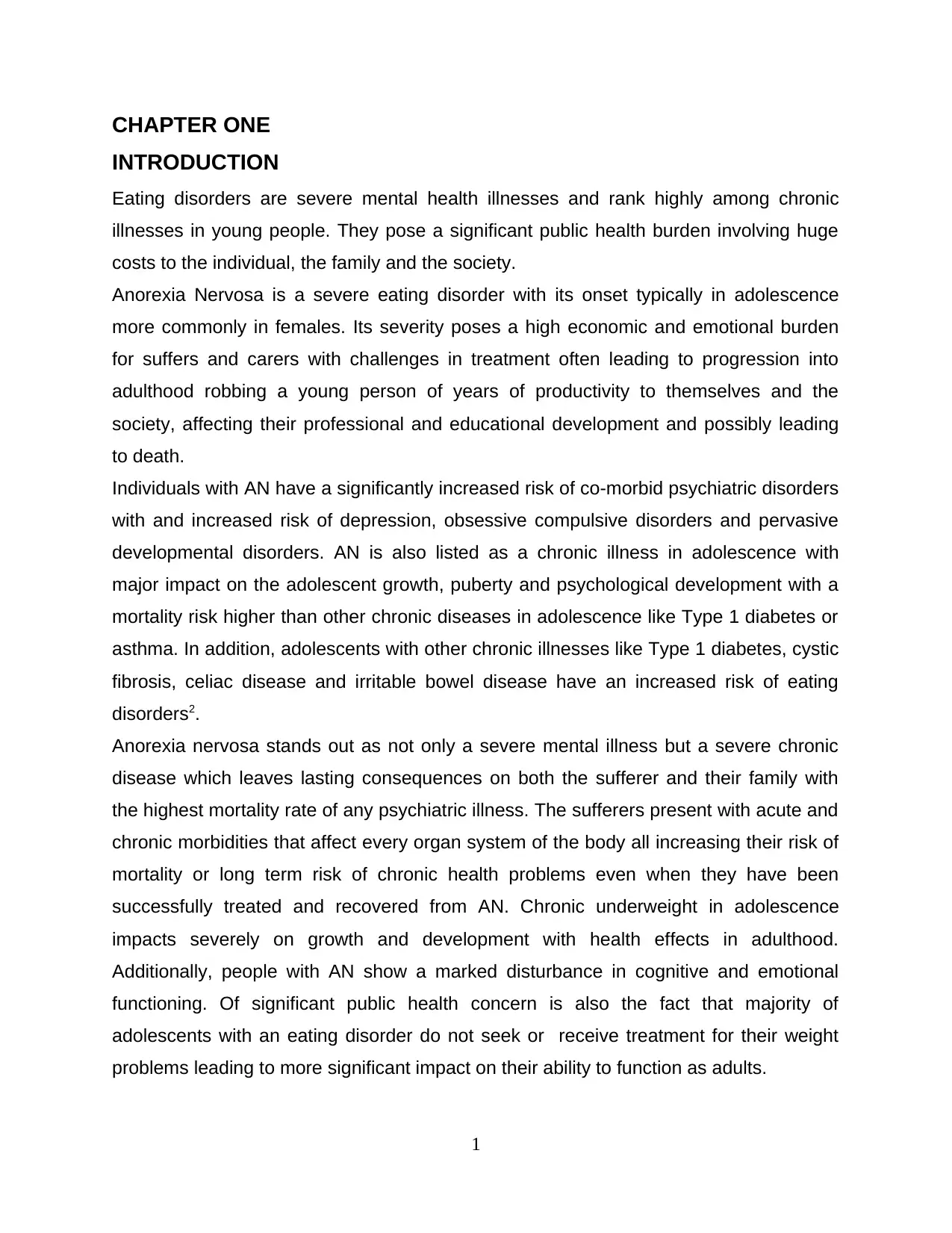
CHAPTER ONE
INTRODUCTION
Eating disorders are severe mental health illnesses and rank highly among chronic
illnesses in young people. They pose a significant public health burden involving huge
costs to the individual, the family and the society.
Anorexia Nervosa is a severe eating disorder with its onset typically in adolescence
more commonly in females. Its severity poses a high economic and emotional burden
for suffers and carers with challenges in treatment often leading to progression into
adulthood robbing a young person of years of productivity to themselves and the
society, affecting their professional and educational development and possibly leading
to death.
Individuals with AN have a significantly increased risk of co-morbid psychiatric disorders
with and increased risk of depression, obsessive compulsive disorders and pervasive
developmental disorders. AN is also listed as a chronic illness in adolescence with
major impact on the adolescent growth, puberty and psychological development with a
mortality risk higher than other chronic diseases in adolescence like Type 1 diabetes or
asthma. In addition, adolescents with other chronic illnesses like Type 1 diabetes, cystic
fibrosis, celiac disease and irritable bowel disease have an increased risk of eating
disorders2.
Anorexia nervosa stands out as not only a severe mental illness but a severe chronic
disease which leaves lasting consequences on both the sufferer and their family with
the highest mortality rate of any psychiatric illness. The sufferers present with acute and
chronic morbidities that affect every organ system of the body all increasing their risk of
mortality or long term risk of chronic health problems even when they have been
successfully treated and recovered from AN. Chronic underweight in adolescence
impacts severely on growth and development with health effects in adulthood.
Additionally, people with AN show a marked disturbance in cognitive and emotional
functioning. Of significant public health concern is also the fact that majority of
adolescents with an eating disorder do not seek or receive treatment for their weight
problems leading to more significant impact on their ability to function as adults.
1
INTRODUCTION
Eating disorders are severe mental health illnesses and rank highly among chronic
illnesses in young people. They pose a significant public health burden involving huge
costs to the individual, the family and the society.
Anorexia Nervosa is a severe eating disorder with its onset typically in adolescence
more commonly in females. Its severity poses a high economic and emotional burden
for suffers and carers with challenges in treatment often leading to progression into
adulthood robbing a young person of years of productivity to themselves and the
society, affecting their professional and educational development and possibly leading
to death.
Individuals with AN have a significantly increased risk of co-morbid psychiatric disorders
with and increased risk of depression, obsessive compulsive disorders and pervasive
developmental disorders. AN is also listed as a chronic illness in adolescence with
major impact on the adolescent growth, puberty and psychological development with a
mortality risk higher than other chronic diseases in adolescence like Type 1 diabetes or
asthma. In addition, adolescents with other chronic illnesses like Type 1 diabetes, cystic
fibrosis, celiac disease and irritable bowel disease have an increased risk of eating
disorders2.
Anorexia nervosa stands out as not only a severe mental illness but a severe chronic
disease which leaves lasting consequences on both the sufferer and their family with
the highest mortality rate of any psychiatric illness. The sufferers present with acute and
chronic morbidities that affect every organ system of the body all increasing their risk of
mortality or long term risk of chronic health problems even when they have been
successfully treated and recovered from AN. Chronic underweight in adolescence
impacts severely on growth and development with health effects in adulthood.
Additionally, people with AN show a marked disturbance in cognitive and emotional
functioning. Of significant public health concern is also the fact that majority of
adolescents with an eating disorder do not seek or receive treatment for their weight
problems leading to more significant impact on their ability to function as adults.
1
Paraphrase This Document
Need a fresh take? Get an instant paraphrase of this document with our AI Paraphraser
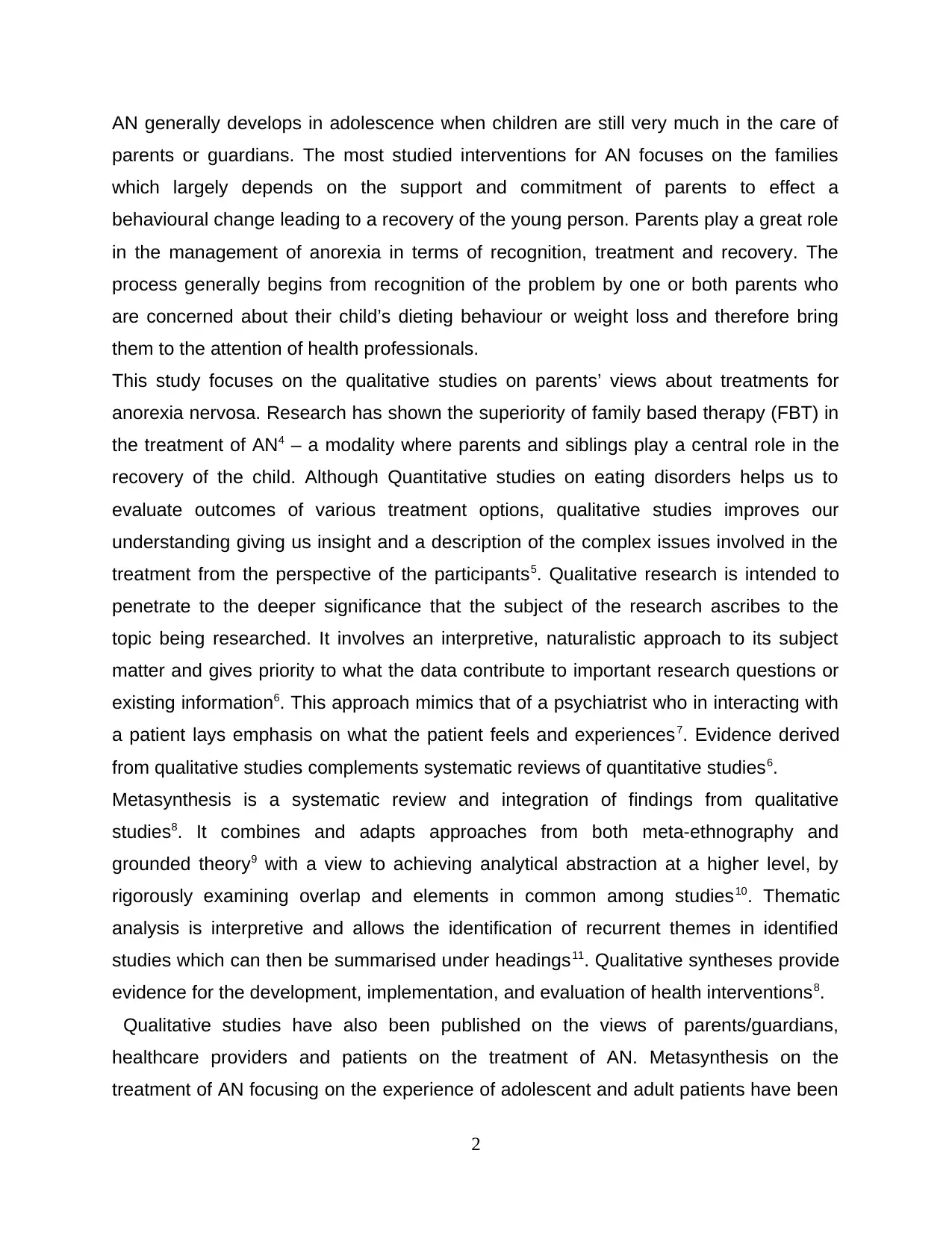
AN generally develops in adolescence when children are still very much in the care of
parents or guardians. The most studied interventions for AN focuses on the families
which largely depends on the support and commitment of parents to effect a
behavioural change leading to a recovery of the young person. Parents play a great role
in the management of anorexia in terms of recognition, treatment and recovery. The
process generally begins from recognition of the problem by one or both parents who
are concerned about their child’s dieting behaviour or weight loss and therefore bring
them to the attention of health professionals.
This study focuses on the qualitative studies on parents’ views about treatments for
anorexia nervosa. Research has shown the superiority of family based therapy (FBT) in
the treatment of AN4 – a modality where parents and siblings play a central role in the
recovery of the child. Although Quantitative studies on eating disorders helps us to
evaluate outcomes of various treatment options, qualitative studies improves our
understanding giving us insight and a description of the complex issues involved in the
treatment from the perspective of the participants5. Qualitative research is intended to
penetrate to the deeper significance that the subject of the research ascribes to the
topic being researched. It involves an interpretive, naturalistic approach to its subject
matter and gives priority to what the data contribute to important research questions or
existing information6. This approach mimics that of a psychiatrist who in interacting with
a patient lays emphasis on what the patient feels and experiences7. Evidence derived
from qualitative studies complements systematic reviews of quantitative studies6.
Metasynthesis is a systematic review and integration of findings from qualitative
studies8. It combines and adapts approaches from both meta-ethnography and
grounded theory9 with a view to achieving analytical abstraction at a higher level, by
rigorously examining overlap and elements in common among studies10. Thematic
analysis is interpretive and allows the identification of recurrent themes in identified
studies which can then be summarised under headings11. Qualitative syntheses provide
evidence for the development, implementation, and evaluation of health interventions8.
Qualitative studies have also been published on the views of parents/guardians,
healthcare providers and patients on the treatment of AN. Metasynthesis on the
treatment of AN focusing on the experience of adolescent and adult patients have been
2
parents or guardians. The most studied interventions for AN focuses on the families
which largely depends on the support and commitment of parents to effect a
behavioural change leading to a recovery of the young person. Parents play a great role
in the management of anorexia in terms of recognition, treatment and recovery. The
process generally begins from recognition of the problem by one or both parents who
are concerned about their child’s dieting behaviour or weight loss and therefore bring
them to the attention of health professionals.
This study focuses on the qualitative studies on parents’ views about treatments for
anorexia nervosa. Research has shown the superiority of family based therapy (FBT) in
the treatment of AN4 – a modality where parents and siblings play a central role in the
recovery of the child. Although Quantitative studies on eating disorders helps us to
evaluate outcomes of various treatment options, qualitative studies improves our
understanding giving us insight and a description of the complex issues involved in the
treatment from the perspective of the participants5. Qualitative research is intended to
penetrate to the deeper significance that the subject of the research ascribes to the
topic being researched. It involves an interpretive, naturalistic approach to its subject
matter and gives priority to what the data contribute to important research questions or
existing information6. This approach mimics that of a psychiatrist who in interacting with
a patient lays emphasis on what the patient feels and experiences7. Evidence derived
from qualitative studies complements systematic reviews of quantitative studies6.
Metasynthesis is a systematic review and integration of findings from qualitative
studies8. It combines and adapts approaches from both meta-ethnography and
grounded theory9 with a view to achieving analytical abstraction at a higher level, by
rigorously examining overlap and elements in common among studies10. Thematic
analysis is interpretive and allows the identification of recurrent themes in identified
studies which can then be summarised under headings11. Qualitative syntheses provide
evidence for the development, implementation, and evaluation of health interventions8.
Qualitative studies have also been published on the views of parents/guardians,
healthcare providers and patients on the treatment of AN. Metasynthesis on the
treatment of AN focusing on the experience of adolescent and adult patients have been
2
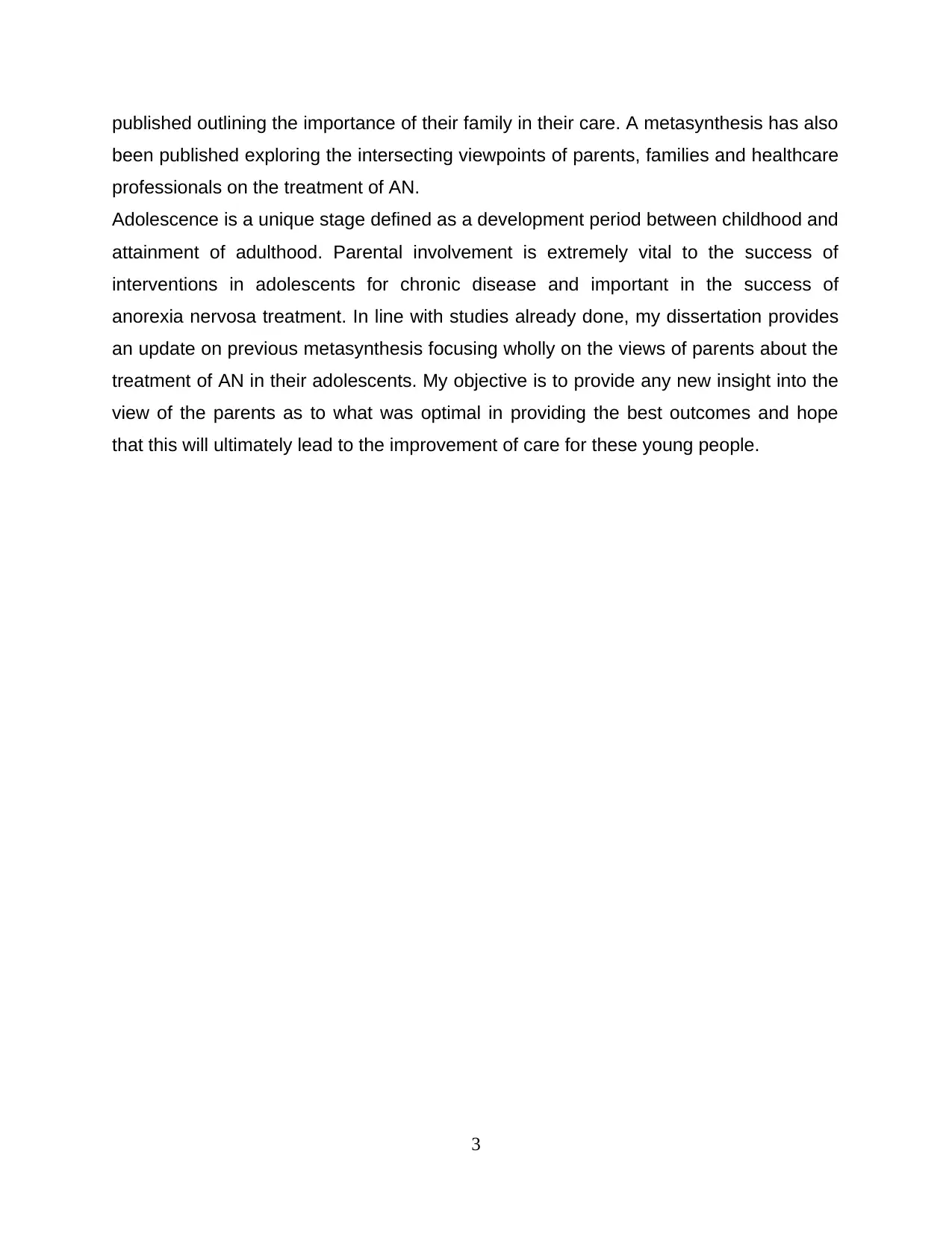
published outlining the importance of their family in their care. A metasynthesis has also
been published exploring the intersecting viewpoints of parents, families and healthcare
professionals on the treatment of AN.
Adolescence is a unique stage defined as a development period between childhood and
attainment of adulthood. Parental involvement is extremely vital to the success of
interventions in adolescents for chronic disease and important in the success of
anorexia nervosa treatment. In line with studies already done, my dissertation provides
an update on previous metasynthesis focusing wholly on the views of parents about the
treatment of AN in their adolescents. My objective is to provide any new insight into the
view of the parents as to what was optimal in providing the best outcomes and hope
that this will ultimately lead to the improvement of care for these young people.
3
been published exploring the intersecting viewpoints of parents, families and healthcare
professionals on the treatment of AN.
Adolescence is a unique stage defined as a development period between childhood and
attainment of adulthood. Parental involvement is extremely vital to the success of
interventions in adolescents for chronic disease and important in the success of
anorexia nervosa treatment. In line with studies already done, my dissertation provides
an update on previous metasynthesis focusing wholly on the views of parents about the
treatment of AN in their adolescents. My objective is to provide any new insight into the
view of the parents as to what was optimal in providing the best outcomes and hope
that this will ultimately lead to the improvement of care for these young people.
3
⊘ This is a preview!⊘
Do you want full access?
Subscribe today to unlock all pages.

Trusted by 1+ million students worldwide
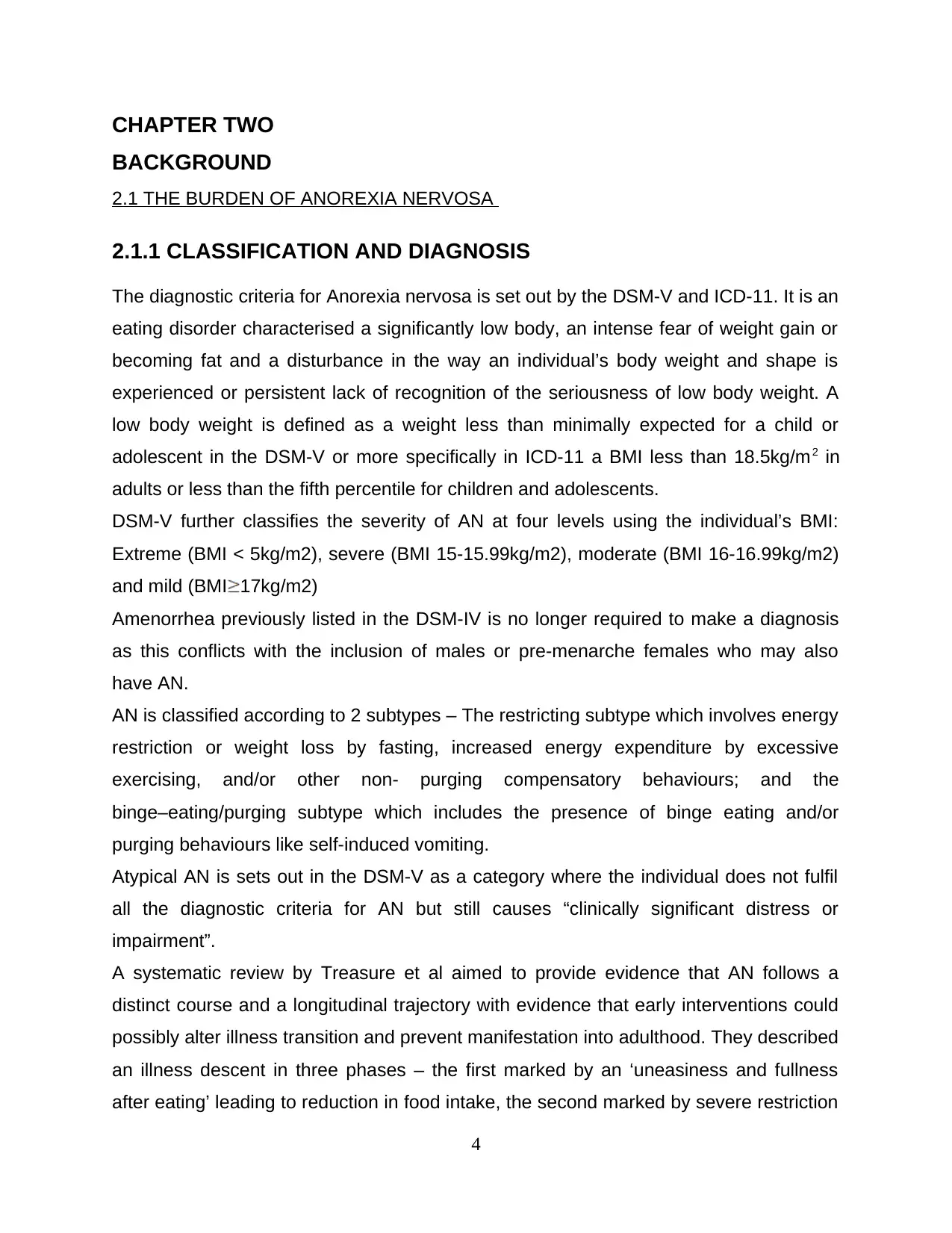
CHAPTER TWO
BACKGROUND
2.1 THE BURDEN OF ANOREXIA NERVOSA
2.1.1 CLASSIFICATION AND DIAGNOSIS
The diagnostic criteria for Anorexia nervosa is set out by the DSM-V and ICD-11. It is an
eating disorder characterised a significantly low body, an intense fear of weight gain or
becoming fat and a disturbance in the way an individual’s body weight and shape is
experienced or persistent lack of recognition of the seriousness of low body weight. A
low body weight is defined as a weight less than minimally expected for a child or
adolescent in the DSM-V or more specifically in ICD-11 a BMI less than 18.5kg/m2 in
adults or less than the fifth percentile for children and adolescents.
DSM-V further classifies the severity of AN at four levels using the individual’s BMI:
Extreme (BMI < 5kg/m2), severe (BMI 15-15.99kg/m2), moderate (BMI 16-16.99kg/m2)
and mild (BMI 17kg/m2)
Amenorrhea previously listed in the DSM-IV is no longer required to make a diagnosis
as this conflicts with the inclusion of males or pre-menarche females who may also
have AN.
AN is classified according to 2 subtypes – The restricting subtype which involves energy
restriction or weight loss by fasting, increased energy expenditure by excessive
exercising, and/or other non- purging compensatory behaviours; and the
binge–eating/purging subtype which includes the presence of binge eating and/or
purging behaviours like self-induced vomiting.
Atypical AN is sets out in the DSM-V as a category where the individual does not fulfil
all the diagnostic criteria for AN but still causes “clinically significant distress or
impairment”.
A systematic review by Treasure et al aimed to provide evidence that AN follows a
distinct course and a longitudinal trajectory with evidence that early interventions could
possibly alter illness transition and prevent manifestation into adulthood. They described
an illness descent in three phases – the first marked by an ‘uneasiness and fullness
after eating’ leading to reduction in food intake, the second marked by severe restriction
4
BACKGROUND
2.1 THE BURDEN OF ANOREXIA NERVOSA
2.1.1 CLASSIFICATION AND DIAGNOSIS
The diagnostic criteria for Anorexia nervosa is set out by the DSM-V and ICD-11. It is an
eating disorder characterised a significantly low body, an intense fear of weight gain or
becoming fat and a disturbance in the way an individual’s body weight and shape is
experienced or persistent lack of recognition of the seriousness of low body weight. A
low body weight is defined as a weight less than minimally expected for a child or
adolescent in the DSM-V or more specifically in ICD-11 a BMI less than 18.5kg/m2 in
adults or less than the fifth percentile for children and adolescents.
DSM-V further classifies the severity of AN at four levels using the individual’s BMI:
Extreme (BMI < 5kg/m2), severe (BMI 15-15.99kg/m2), moderate (BMI 16-16.99kg/m2)
and mild (BMI 17kg/m2)
Amenorrhea previously listed in the DSM-IV is no longer required to make a diagnosis
as this conflicts with the inclusion of males or pre-menarche females who may also
have AN.
AN is classified according to 2 subtypes – The restricting subtype which involves energy
restriction or weight loss by fasting, increased energy expenditure by excessive
exercising, and/or other non- purging compensatory behaviours; and the
binge–eating/purging subtype which includes the presence of binge eating and/or
purging behaviours like self-induced vomiting.
Atypical AN is sets out in the DSM-V as a category where the individual does not fulfil
all the diagnostic criteria for AN but still causes “clinically significant distress or
impairment”.
A systematic review by Treasure et al aimed to provide evidence that AN follows a
distinct course and a longitudinal trajectory with evidence that early interventions could
possibly alter illness transition and prevent manifestation into adulthood. They described
an illness descent in three phases – the first marked by an ‘uneasiness and fullness
after eating’ leading to reduction in food intake, the second marked by severe restriction
4
Paraphrase This Document
Need a fresh take? Get an instant paraphrase of this document with our AI Paraphraser
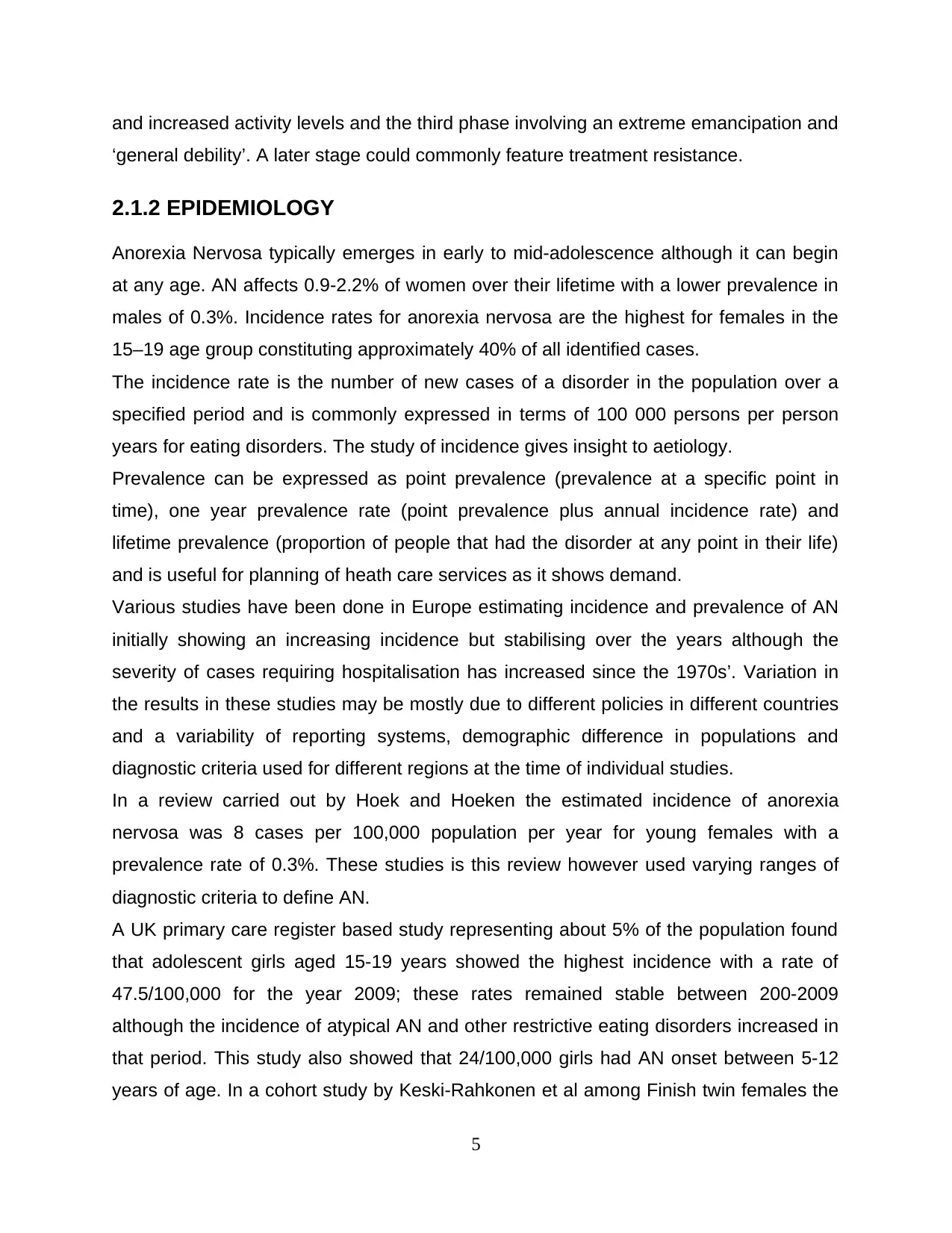
and increased activity levels and the third phase involving an extreme emancipation and
‘general debility’. A later stage could commonly feature treatment resistance.
2.1.2 EPIDEMIOLOGY
Anorexia Nervosa typically emerges in early to mid-adolescence although it can begin
at any age. AN affects 0.9-2.2% of women over their lifetime with a lower prevalence in
males of 0.3%. Incidence rates for anorexia nervosa are the highest for females in the
15–19 age group constituting approximately 40% of all identified cases.
The incidence rate is the number of new cases of a disorder in the population over a
specified period and is commonly expressed in terms of 100 000 persons per person
years for eating disorders. The study of incidence gives insight to aetiology.
Prevalence can be expressed as point prevalence (prevalence at a specific point in
time), one year prevalence rate (point prevalence plus annual incidence rate) and
lifetime prevalence (proportion of people that had the disorder at any point in their life)
and is useful for planning of heath care services as it shows demand.
Various studies have been done in Europe estimating incidence and prevalence of AN
initially showing an increasing incidence but stabilising over the years although the
severity of cases requiring hospitalisation has increased since the 1970s’. Variation in
the results in these studies may be mostly due to different policies in different countries
and a variability of reporting systems, demographic difference in populations and
diagnostic criteria used for different regions at the time of individual studies.
In a review carried out by Hoek and Hoeken the estimated incidence of anorexia
nervosa was 8 cases per 100,000 population per year for young females with a
prevalence rate of 0.3%. These studies is this review however used varying ranges of
diagnostic criteria to define AN.
A UK primary care register based study representing about 5% of the population found
that adolescent girls aged 15-19 years showed the highest incidence with a rate of
47.5/100,000 for the year 2009; these rates remained stable between 200-2009
although the incidence of atypical AN and other restrictive eating disorders increased in
that period. This study also showed that 24/100,000 girls had AN onset between 5-12
years of age. In a cohort study by Keski-Rahkonen et al among Finish twin females the
5
‘general debility’. A later stage could commonly feature treatment resistance.
2.1.2 EPIDEMIOLOGY
Anorexia Nervosa typically emerges in early to mid-adolescence although it can begin
at any age. AN affects 0.9-2.2% of women over their lifetime with a lower prevalence in
males of 0.3%. Incidence rates for anorexia nervosa are the highest for females in the
15–19 age group constituting approximately 40% of all identified cases.
The incidence rate is the number of new cases of a disorder in the population over a
specified period and is commonly expressed in terms of 100 000 persons per person
years for eating disorders. The study of incidence gives insight to aetiology.
Prevalence can be expressed as point prevalence (prevalence at a specific point in
time), one year prevalence rate (point prevalence plus annual incidence rate) and
lifetime prevalence (proportion of people that had the disorder at any point in their life)
and is useful for planning of heath care services as it shows demand.
Various studies have been done in Europe estimating incidence and prevalence of AN
initially showing an increasing incidence but stabilising over the years although the
severity of cases requiring hospitalisation has increased since the 1970s’. Variation in
the results in these studies may be mostly due to different policies in different countries
and a variability of reporting systems, demographic difference in populations and
diagnostic criteria used for different regions at the time of individual studies.
In a review carried out by Hoek and Hoeken the estimated incidence of anorexia
nervosa was 8 cases per 100,000 population per year for young females with a
prevalence rate of 0.3%. These studies is this review however used varying ranges of
diagnostic criteria to define AN.
A UK primary care register based study representing about 5% of the population found
that adolescent girls aged 15-19 years showed the highest incidence with a rate of
47.5/100,000 for the year 2009; these rates remained stable between 200-2009
although the incidence of atypical AN and other restrictive eating disorders increased in
that period. This study also showed that 24/100,000 girls had AN onset between 5-12
years of age. In a cohort study by Keski-Rahkonen et al among Finish twin females the
5
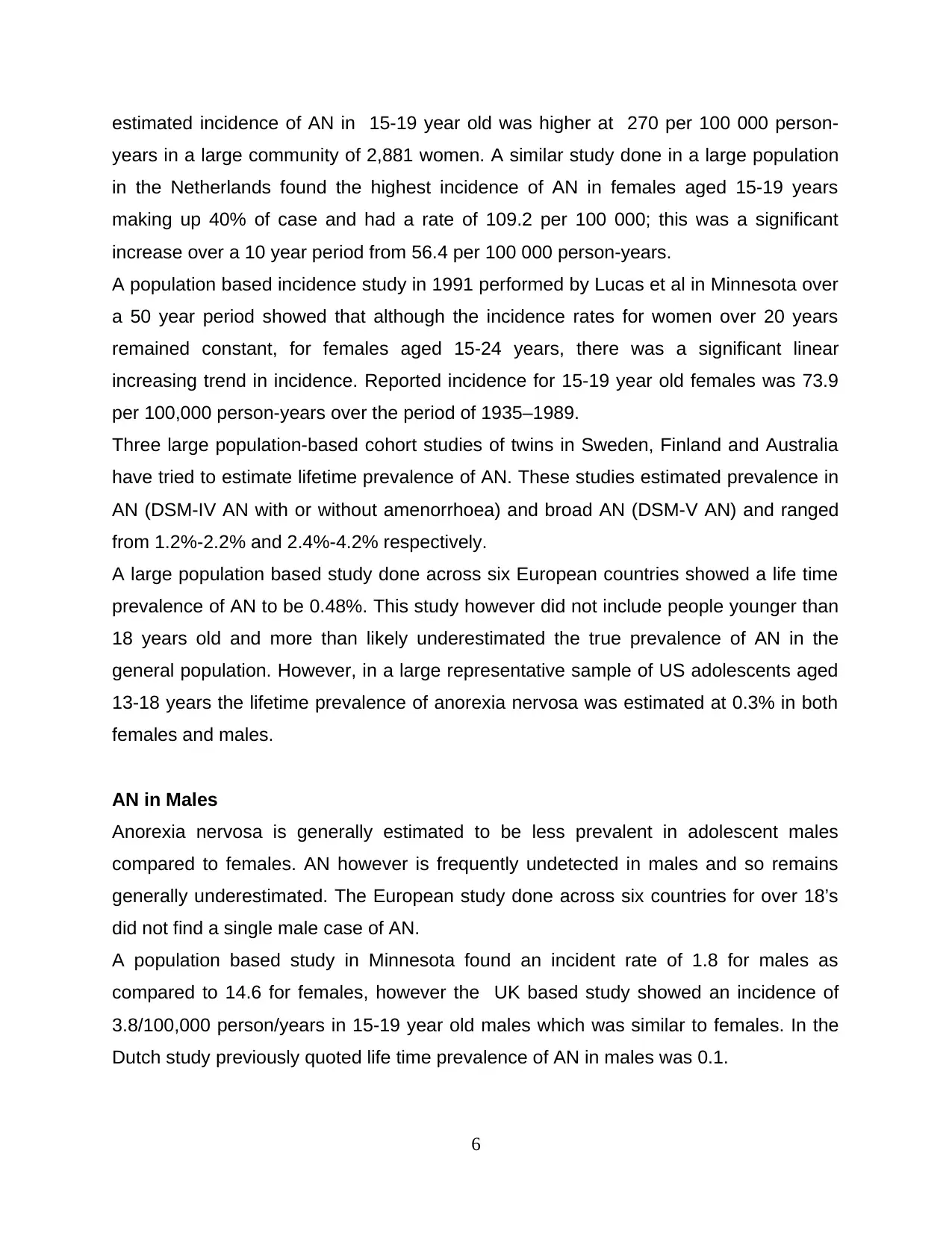
estimated incidence of AN in 15-19 year old was higher at 270 per 100 000 person-
years in a large community of 2,881 women. A similar study done in a large population
in the Netherlands found the highest incidence of AN in females aged 15-19 years
making up 40% of case and had a rate of 109.2 per 100 000; this was a significant
increase over a 10 year period from 56.4 per 100 000 person-years.
A population based incidence study in 1991 performed by Lucas et al in Minnesota over
a 50 year period showed that although the incidence rates for women over 20 years
remained constant, for females aged 15-24 years, there was a significant linear
increasing trend in incidence. Reported incidence for 15-19 year old females was 73.9
per 100,000 person-years over the period of 1935–1989.
Three large population-based cohort studies of twins in Sweden, Finland and Australia
have tried to estimate lifetime prevalence of AN. These studies estimated prevalence in
AN (DSM-IV AN with or without amenorrhoea) and broad AN (DSM-V AN) and ranged
from 1.2%-2.2% and 2.4%-4.2% respectively.
A large population based study done across six European countries showed a life time
prevalence of AN to be 0.48%. This study however did not include people younger than
18 years old and more than likely underestimated the true prevalence of AN in the
general population. However, in a large representative sample of US adolescents aged
13-18 years the lifetime prevalence of anorexia nervosa was estimated at 0.3% in both
females and males.
AN in Males
Anorexia nervosa is generally estimated to be less prevalent in adolescent males
compared to females. AN however is frequently undetected in males and so remains
generally underestimated. The European study done across six countries for over 18’s
did not find a single male case of AN.
A population based study in Minnesota found an incident rate of 1.8 for males as
compared to 14.6 for females, however the UK based study showed an incidence of
3.8/100,000 person/years in 15-19 year old males which was similar to females. In the
Dutch study previously quoted life time prevalence of AN in males was 0.1.
6
years in a large community of 2,881 women. A similar study done in a large population
in the Netherlands found the highest incidence of AN in females aged 15-19 years
making up 40% of case and had a rate of 109.2 per 100 000; this was a significant
increase over a 10 year period from 56.4 per 100 000 person-years.
A population based incidence study in 1991 performed by Lucas et al in Minnesota over
a 50 year period showed that although the incidence rates for women over 20 years
remained constant, for females aged 15-24 years, there was a significant linear
increasing trend in incidence. Reported incidence for 15-19 year old females was 73.9
per 100,000 person-years over the period of 1935–1989.
Three large population-based cohort studies of twins in Sweden, Finland and Australia
have tried to estimate lifetime prevalence of AN. These studies estimated prevalence in
AN (DSM-IV AN with or without amenorrhoea) and broad AN (DSM-V AN) and ranged
from 1.2%-2.2% and 2.4%-4.2% respectively.
A large population based study done across six European countries showed a life time
prevalence of AN to be 0.48%. This study however did not include people younger than
18 years old and more than likely underestimated the true prevalence of AN in the
general population. However, in a large representative sample of US adolescents aged
13-18 years the lifetime prevalence of anorexia nervosa was estimated at 0.3% in both
females and males.
AN in Males
Anorexia nervosa is generally estimated to be less prevalent in adolescent males
compared to females. AN however is frequently undetected in males and so remains
generally underestimated. The European study done across six countries for over 18’s
did not find a single male case of AN.
A population based study in Minnesota found an incident rate of 1.8 for males as
compared to 14.6 for females, however the UK based study showed an incidence of
3.8/100,000 person/years in 15-19 year old males which was similar to females. In the
Dutch study previously quoted life time prevalence of AN in males was 0.1.
6
⊘ This is a preview!⊘
Do you want full access?
Subscribe today to unlock all pages.

Trusted by 1+ million students worldwide
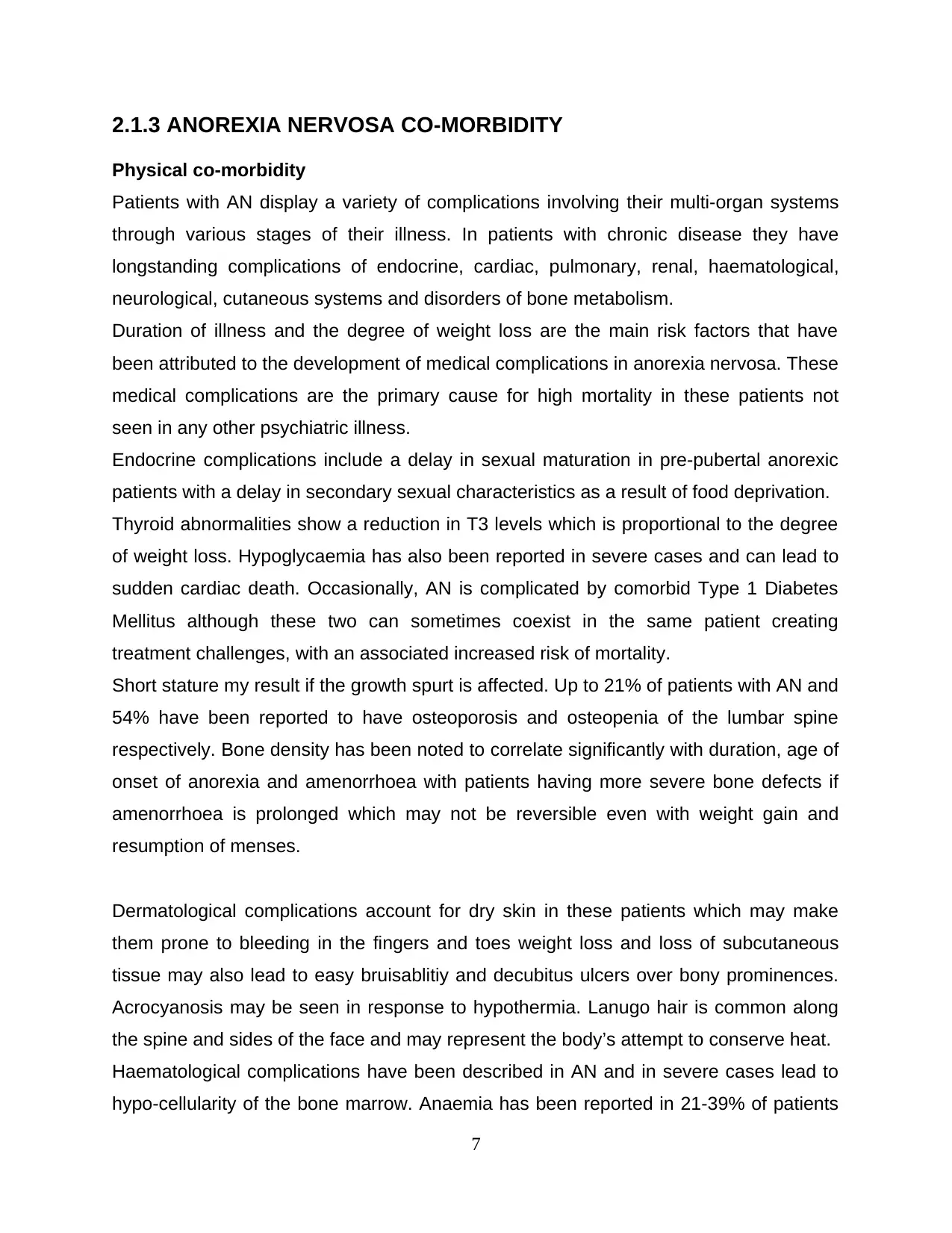
2.1.3 ANOREXIA NERVOSA CO-MORBIDITY
Physical co-morbidity
Patients with AN display a variety of complications involving their multi-organ systems
through various stages of their illness. In patients with chronic disease they have
longstanding complications of endocrine, cardiac, pulmonary, renal, haematological,
neurological, cutaneous systems and disorders of bone metabolism.
Duration of illness and the degree of weight loss are the main risk factors that have
been attributed to the development of medical complications in anorexia nervosa. These
medical complications are the primary cause for high mortality in these patients not
seen in any other psychiatric illness.
Endocrine complications include a delay in sexual maturation in pre‐pubertal anorexic
patients with a delay in secondary sexual characteristics as a result of food deprivation.
Thyroid abnormalities show a reduction in T3 levels which is proportional to the degree
of weight loss. Hypoglycaemia has also been reported in severe cases and can lead to
sudden cardiac death. Occasionally, AN is complicated by comorbid Type 1 Diabetes
Mellitus although these two can sometimes coexist in the same patient creating
treatment challenges, with an associated increased risk of mortality.
Short stature my result if the growth spurt is affected. Up to 21% of patients with AN and
54% have been reported to have osteoporosis and osteopenia of the lumbar spine
respectively. Bone density has been noted to correlate significantly with duration, age of
onset of anorexia and amenorrhoea with patients having more severe bone defects if
amenorrhoea is prolonged which may not be reversible even with weight gain and
resumption of menses.
Dermatological complications account for dry skin in these patients which may make
them prone to bleeding in the fingers and toes weight loss and loss of subcutaneous
tissue may also lead to easy bruisablitiy and decubitus ulcers over bony prominences.
Acrocyanosis may be seen in response to hypothermia. Lanugo hair is common along
the spine and sides of the face and may represent the body’s attempt to conserve heat.
Haematological complications have been described in AN and in severe cases lead to
hypo-cellularity of the bone marrow. Anaemia has been reported in 21-39% of patients
7
Physical co-morbidity
Patients with AN display a variety of complications involving their multi-organ systems
through various stages of their illness. In patients with chronic disease they have
longstanding complications of endocrine, cardiac, pulmonary, renal, haematological,
neurological, cutaneous systems and disorders of bone metabolism.
Duration of illness and the degree of weight loss are the main risk factors that have
been attributed to the development of medical complications in anorexia nervosa. These
medical complications are the primary cause for high mortality in these patients not
seen in any other psychiatric illness.
Endocrine complications include a delay in sexual maturation in pre‐pubertal anorexic
patients with a delay in secondary sexual characteristics as a result of food deprivation.
Thyroid abnormalities show a reduction in T3 levels which is proportional to the degree
of weight loss. Hypoglycaemia has also been reported in severe cases and can lead to
sudden cardiac death. Occasionally, AN is complicated by comorbid Type 1 Diabetes
Mellitus although these two can sometimes coexist in the same patient creating
treatment challenges, with an associated increased risk of mortality.
Short stature my result if the growth spurt is affected. Up to 21% of patients with AN and
54% have been reported to have osteoporosis and osteopenia of the lumbar spine
respectively. Bone density has been noted to correlate significantly with duration, age of
onset of anorexia and amenorrhoea with patients having more severe bone defects if
amenorrhoea is prolonged which may not be reversible even with weight gain and
resumption of menses.
Dermatological complications account for dry skin in these patients which may make
them prone to bleeding in the fingers and toes weight loss and loss of subcutaneous
tissue may also lead to easy bruisablitiy and decubitus ulcers over bony prominences.
Acrocyanosis may be seen in response to hypothermia. Lanugo hair is common along
the spine and sides of the face and may represent the body’s attempt to conserve heat.
Haematological complications have been described in AN and in severe cases lead to
hypo-cellularity of the bone marrow. Anaemia has been reported in 21-39% of patients
7
Paraphrase This Document
Need a fresh take? Get an instant paraphrase of this document with our AI Paraphraser
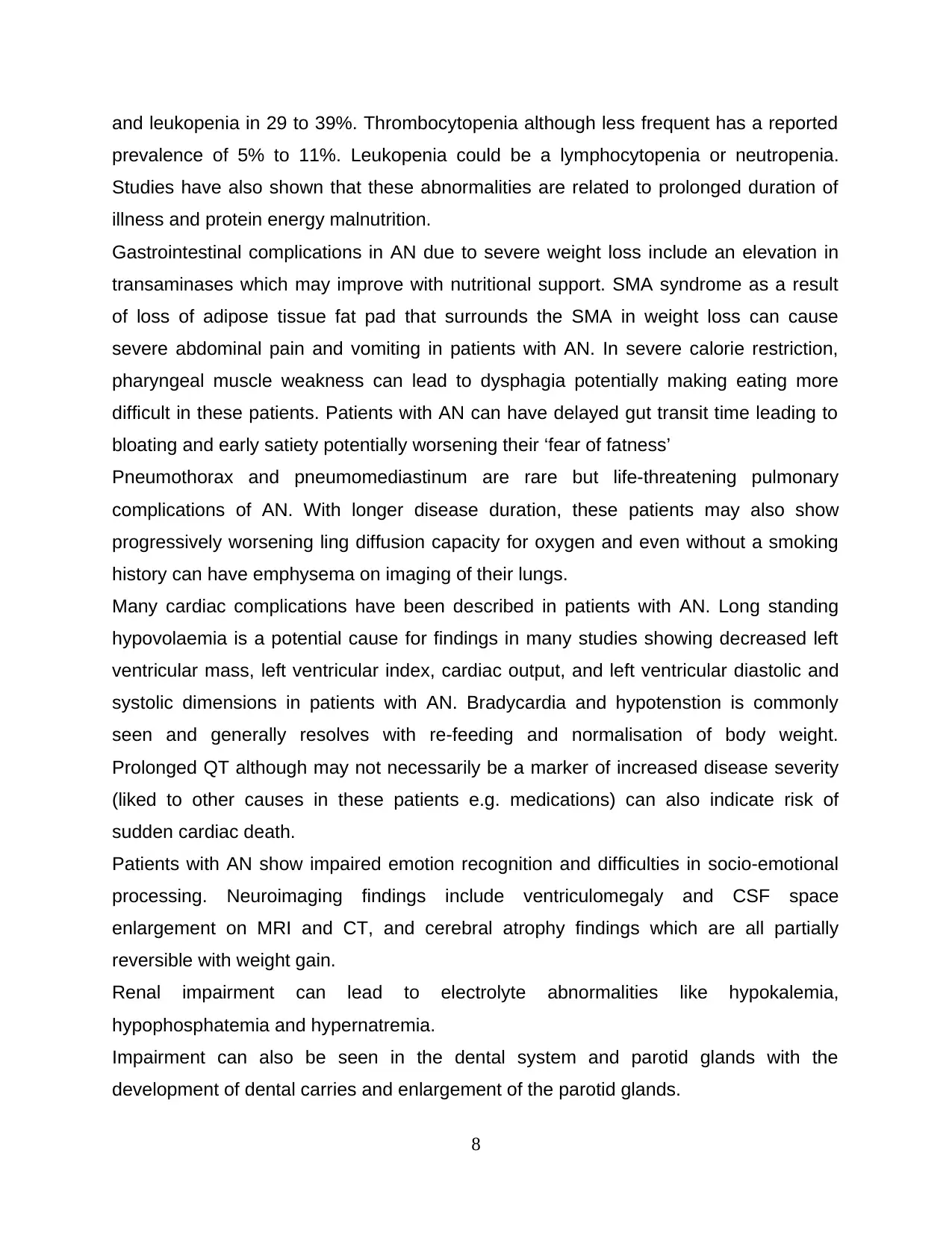
and leukopenia in 29 to 39%. Thrombocytopenia although less frequent has a reported
prevalence of 5% to 11%. Leukopenia could be a lymphocytopenia or neutropenia.
Studies have also shown that these abnormalities are related to prolonged duration of
illness and protein energy malnutrition.
Gastrointestinal complications in AN due to severe weight loss include an elevation in
transaminases which may improve with nutritional support. SMA syndrome as a result
of loss of adipose tissue fat pad that surrounds the SMA in weight loss can cause
severe abdominal pain and vomiting in patients with AN. In severe calorie restriction,
pharyngeal muscle weakness can lead to dysphagia potentially making eating more
difficult in these patients. Patients with AN can have delayed gut transit time leading to
bloating and early satiety potentially worsening their ‘fear of fatness’
Pneumothorax and pneumomediastinum are rare but life-threatening pulmonary
complications of AN. With longer disease duration, these patients may also show
progressively worsening ling diffusion capacity for oxygen and even without a smoking
history can have emphysema on imaging of their lungs.
Many cardiac complications have been described in patients with AN. Long standing
hypovolaemia is a potential cause for findings in many studies showing decreased left
ventricular mass, left ventricular index, cardiac output, and left ventricular diastolic and
systolic dimensions in patients with AN. Bradycardia and hypotenstion is commonly
seen and generally resolves with re-feeding and normalisation of body weight.
Prolonged QT although may not necessarily be a marker of increased disease severity
(liked to other causes in these patients e.g. medications) can also indicate risk of
sudden cardiac death.
Patients with AN show impaired emotion recognition and difficulties in socio-emotional
processing. Neuroimaging findings include ventriculomegaly and CSF space
enlargement on MRI and CT, and cerebral atrophy findings which are all partially
reversible with weight gain.
Renal impairment can lead to electrolyte abnormalities like hypokalemia,
hypophosphatemia and hypernatremia.
Impairment can also be seen in the dental system and parotid glands with the
development of dental carries and enlargement of the parotid glands.
8
prevalence of 5% to 11%. Leukopenia could be a lymphocytopenia or neutropenia.
Studies have also shown that these abnormalities are related to prolonged duration of
illness and protein energy malnutrition.
Gastrointestinal complications in AN due to severe weight loss include an elevation in
transaminases which may improve with nutritional support. SMA syndrome as a result
of loss of adipose tissue fat pad that surrounds the SMA in weight loss can cause
severe abdominal pain and vomiting in patients with AN. In severe calorie restriction,
pharyngeal muscle weakness can lead to dysphagia potentially making eating more
difficult in these patients. Patients with AN can have delayed gut transit time leading to
bloating and early satiety potentially worsening their ‘fear of fatness’
Pneumothorax and pneumomediastinum are rare but life-threatening pulmonary
complications of AN. With longer disease duration, these patients may also show
progressively worsening ling diffusion capacity for oxygen and even without a smoking
history can have emphysema on imaging of their lungs.
Many cardiac complications have been described in patients with AN. Long standing
hypovolaemia is a potential cause for findings in many studies showing decreased left
ventricular mass, left ventricular index, cardiac output, and left ventricular diastolic and
systolic dimensions in patients with AN. Bradycardia and hypotenstion is commonly
seen and generally resolves with re-feeding and normalisation of body weight.
Prolonged QT although may not necessarily be a marker of increased disease severity
(liked to other causes in these patients e.g. medications) can also indicate risk of
sudden cardiac death.
Patients with AN show impaired emotion recognition and difficulties in socio-emotional
processing. Neuroimaging findings include ventriculomegaly and CSF space
enlargement on MRI and CT, and cerebral atrophy findings which are all partially
reversible with weight gain.
Renal impairment can lead to electrolyte abnormalities like hypokalemia,
hypophosphatemia and hypernatremia.
Impairment can also be seen in the dental system and parotid glands with the
development of dental carries and enlargement of the parotid glands.
8
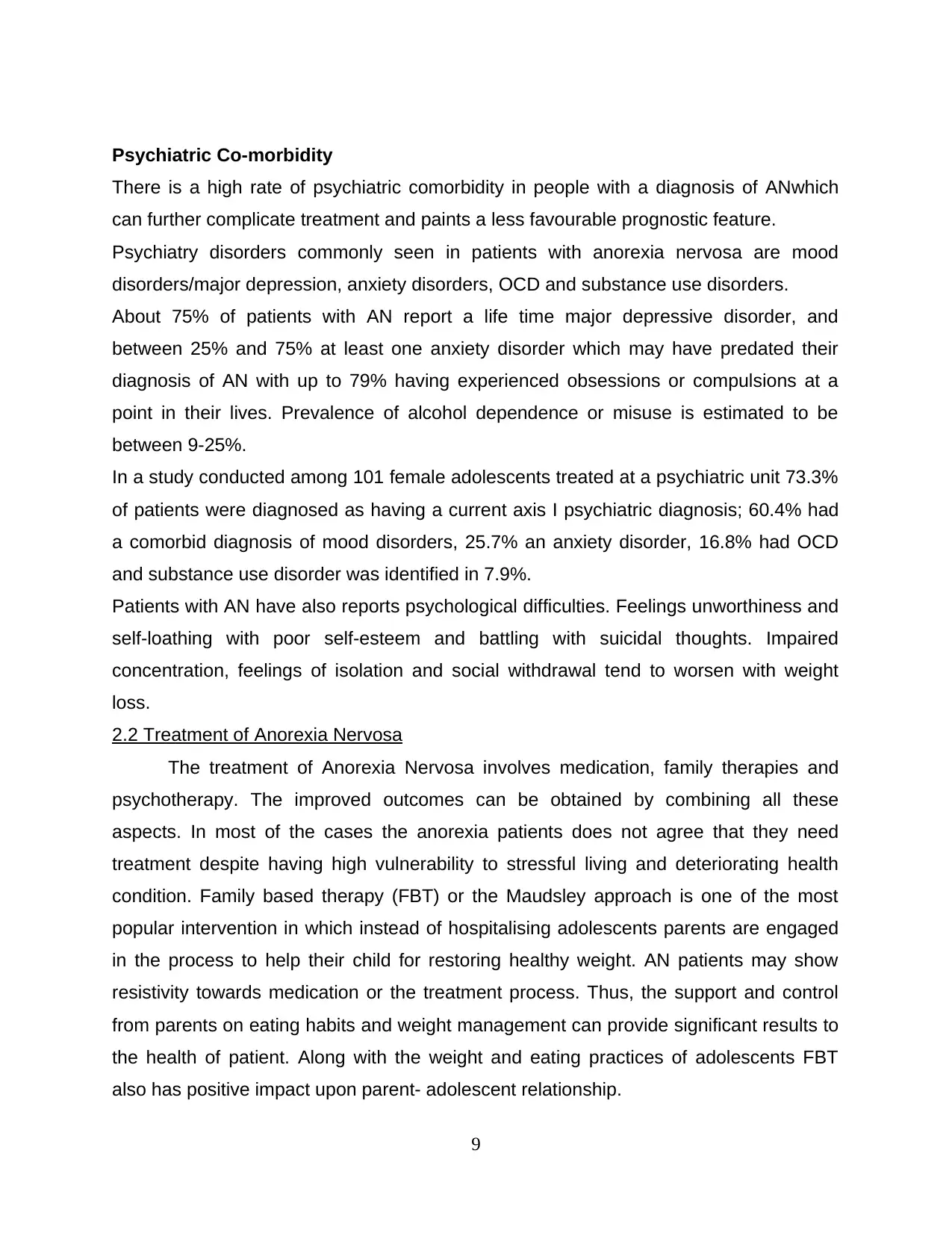
Psychiatric Co-morbidity
There is a high rate of psychiatric comorbidity in people with a diagnosis of ANwhich
can further complicate treatment and paints a less favourable prognostic feature.
Psychiatry disorders commonly seen in patients with anorexia nervosa are mood
disorders/major depression, anxiety disorders, OCD and substance use disorders.
About 75% of patients with AN report a life time major depressive disorder, and
between 25% and 75% at least one anxiety disorder which may have predated their
diagnosis of AN with up to 79% having experienced obsessions or compulsions at a
point in their lives. Prevalence of alcohol dependence or misuse is estimated to be
between 9-25%.
In a study conducted among 101 female adolescents treated at a psychiatric unit 73.3%
of patients were diagnosed as having a current axis I psychiatric diagnosis; 60.4% had
a comorbid diagnosis of mood disorders, 25.7% an anxiety disorder, 16.8% had OCD
and substance use disorder was identified in 7.9%.
Patients with AN have also reports psychological difficulties. Feelings unworthiness and
self-loathing with poor self-esteem and battling with suicidal thoughts. Impaired
concentration, feelings of isolation and social withdrawal tend to worsen with weight
loss.
2.2 Treatment of Anorexia Nervosa
The treatment of Anorexia Nervosa involves medication, family therapies and
psychotherapy. The improved outcomes can be obtained by combining all these
aspects. In most of the cases the anorexia patients does not agree that they need
treatment despite having high vulnerability to stressful living and deteriorating health
condition. Family based therapy (FBT) or the Maudsley approach is one of the most
popular intervention in which instead of hospitalising adolescents parents are engaged
in the process to help their child for restoring healthy weight. AN patients may show
resistivity towards medication or the treatment process. Thus, the support and control
from parents on eating habits and weight management can provide significant results to
the health of patient. Along with the weight and eating practices of adolescents FBT
also has positive impact upon parent- adolescent relationship.
9
There is a high rate of psychiatric comorbidity in people with a diagnosis of ANwhich
can further complicate treatment and paints a less favourable prognostic feature.
Psychiatry disorders commonly seen in patients with anorexia nervosa are mood
disorders/major depression, anxiety disorders, OCD and substance use disorders.
About 75% of patients with AN report a life time major depressive disorder, and
between 25% and 75% at least one anxiety disorder which may have predated their
diagnosis of AN with up to 79% having experienced obsessions or compulsions at a
point in their lives. Prevalence of alcohol dependence or misuse is estimated to be
between 9-25%.
In a study conducted among 101 female adolescents treated at a psychiatric unit 73.3%
of patients were diagnosed as having a current axis I psychiatric diagnosis; 60.4% had
a comorbid diagnosis of mood disorders, 25.7% an anxiety disorder, 16.8% had OCD
and substance use disorder was identified in 7.9%.
Patients with AN have also reports psychological difficulties. Feelings unworthiness and
self-loathing with poor self-esteem and battling with suicidal thoughts. Impaired
concentration, feelings of isolation and social withdrawal tend to worsen with weight
loss.
2.2 Treatment of Anorexia Nervosa
The treatment of Anorexia Nervosa involves medication, family therapies and
psychotherapy. The improved outcomes can be obtained by combining all these
aspects. In most of the cases the anorexia patients does not agree that they need
treatment despite having high vulnerability to stressful living and deteriorating health
condition. Family based therapy (FBT) or the Maudsley approach is one of the most
popular intervention in which instead of hospitalising adolescents parents are engaged
in the process to help their child for restoring healthy weight. AN patients may show
resistivity towards medication or the treatment process. Thus, the support and control
from parents on eating habits and weight management can provide significant results to
the health of patient. Along with the weight and eating practices of adolescents FBT
also has positive impact upon parent- adolescent relationship.
9
⊘ This is a preview!⊘
Do you want full access?
Subscribe today to unlock all pages.

Trusted by 1+ million students worldwide
1 out of 56
Related Documents
Your All-in-One AI-Powered Toolkit for Academic Success.
+13062052269
info@desklib.com
Available 24*7 on WhatsApp / Email
![[object Object]](/_next/static/media/star-bottom.7253800d.svg)
Unlock your academic potential
Copyright © 2020–2025 A2Z Services. All Rights Reserved. Developed and managed by ZUCOL.





